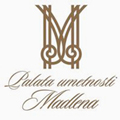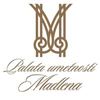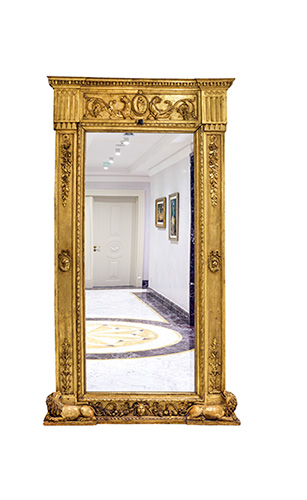![]()
Ogledalo s pozlaćenim drvenim ramom
Oko 1800. godine, Italija
Antički stil se vratio krajem 18. i početkom 19. veka. Car Napoleon, kralj Italije, posle osvajanja, zahteva povratak antičkih linija i figura. Trebalo bi se diviti ravnoteži linija, čistoti elemenata čiji su duborezi takve prefinjenosti kakvu samo italijanski majstori mogu da dosegnu. Sve ipak odiše energijom francuskog cara, o čemu svedoče figure dva lava na dnu stubova.
![]()
Mirror with gold-plated wooden frame
About 1800, Italy
The antique style reoccurred in the end of XVIII and the beginning of XIX century. Following his conquest, Emperor Napoleon, King of Italy, requested return to ancient forms and figures. One cannot but admire the harmony of lines and purity of elements with the woodwork of such sophistication as could only be attained by Italian artisans. However, everything exudes the energy of the French emperor, which is purported by the two figures of lions at the bottom of the posts.
![]()
Miroir dans la monture en bois doré
Vers 1800, Italie
Le style antique est de retour à la fin du 18e siècle et au début du 19e siècle. L’empereur Napoléon, roi d’Italie, après la conquête, exige un retour aux lignes et figures antiques. Il faut admirer ici l’équilibre des lignes, la pureté des ornements dont la gravure est d’une finesse que seuls les maîtres italiens pouvaient atteindre. Toutefois, le tout émane de l’énergie de l’empereur français, comme en témoigne la statuette de deux lions, au pied des piliers.
![]()
Зеркало с позолоченной деревянной рамой
Ок. 1800 г., Италия
Антинчный стиль вернулся в конце XVIII и начале XIX веков. Император Наполеон, король Италии, после завоевания определил возвращение старинных линий и фигур. Следует восхищаться уравновешенностью линий и чистотой элементов, резьба которых отличается такой утонченностью, какую могут достичь только итальянские мастера. Однако, все источает энергию французского императора, о чем свидетельствуют фигуры двух львов у основания колонн.


